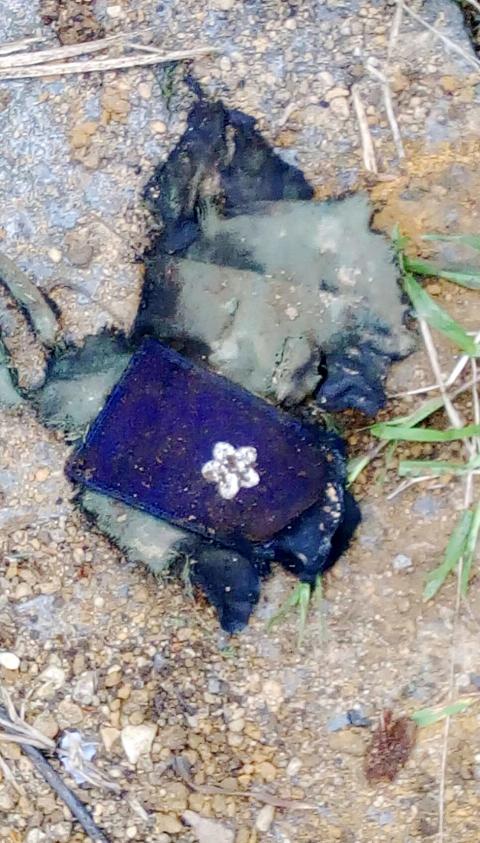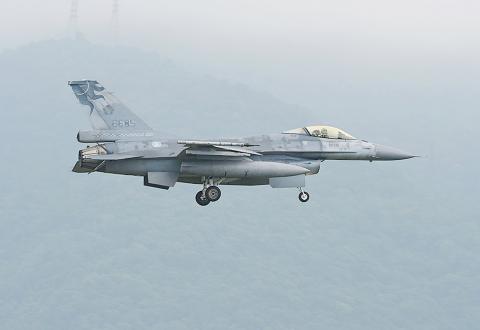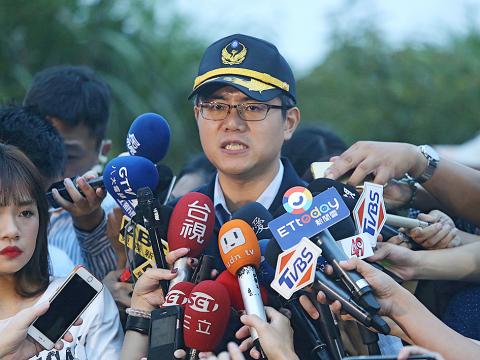The pilot of an F-16 air force jet that went missing yesterday while taking part in the live-fire drills of the annual Han Kuang exercise has been confirmed dead, after rescuers found body parts and other items on Wufenshan (五分山) in New Taipei City.
The air force’s forensic science unit confirmed that the remains belonged to 31-year-old Major Wu Yen-ting (吳彥霆) of the 12th Tactical Reconnaissance Squadron, the Ministry of National Defense said in a statement last night.
Searchers had found blood-stained pieces of the pilot’s anti-G suit and other clothing, as well as body parts in trees at the crash site, it said.

Photo: Liao Chen-huei, Taipei Times
The confirmation of identification came just hours after officers from the 5th Tactical Composite Wing had held an evening press event at the Hualien Air Force Base.
Wu was flying an F-16 with the tail number 6648, which took off from the base at 1:09pm and radar contact was lost at 1:43pm over northern Taiwan, Air Force Command Headquarters had said earlier in the day.
Residents in New Taipei City and Keelung were quoted by local Chinese-language media as saying they heard a loud bang that appeared to come from the mountainous areas around New Taipei City’s Ruifang (瑞芳) and Nuannuan (暖暖) districts.

Photo courtesy of New Taipei City Fire Department
The National Airborne Service Corps and firefighters from Keelung, New Taipei City and Yilan County were deployed to help in the search and rescue efforts.
A hiker telephoned the New Taipei City Fire Department at 3:22pm to say he had found the possible wreckage of the jet, the department said.
At 4:18pm firefighters found what appeared to be the crash site on the Wufenshan hiking trail about 3km from the meteorological radar observatory, the department added.

Photo: Yu Tai-lang, Taipei Times
Firefighters found “a substantial quantity” of debris, including a yellow military drag parachute, many toppled trees, skid marks and a 100m long gash in the woods, it said.
About 6pm, rescuers discovered what they suspected to be human remains and pieces of personal equipment, including the pilot’s G-suit and insignia, which were sent for examination by forensic technicians, officers told the Hualien news conference, which was attended by Major General Hsieh Ming-te (謝明德), director of political warfare at the 6th Army Corps.
Military personnel had identified the parachute as a fighter jet’s drag chute from a photograph taken by the search team.

Photo: CNA
Minister of National Defense Yen De-fa (嚴德發) and Chief of General Staff Admiral Lee Hsi-ming (李喜明) had directed rescue efforts from the Joint Operations Command Center and the Air Force Operational Command Center in Taipei, respectively, the defense ministry said.
The search mission was suspended at 8 pm due to poor visibility, but is scheduled to resume early today to look for more parts of the wreckage.
The air force temporarily grounded all of its F-16s until further notice.
The Office of the Inspector-general of the ministry and the Air Force Command have been ordered to create a task force to investigate the cause of the crash and to enhance safety standards during aerial exercises, the ministry said.
Air Force Command Headquarters said Wu was a 2009 graduate of the Air Force Academy and had 1,039 hours of flight time, including 736 hours in F-16 jets.
Wu had survived a crash in 2013, when his fighter jet’s starter experienced a failure that resulted in loss of power during an interception training, sources said.
He had been able to eject from the aircraft and suffered light injuries, the sources said.
Wu was from Yilan County’s Dongshan Township (冬山).
He is survived by his wife, Lin Fang-ying (林芳瑩), who is also in the air force.
They met when they were stationed at Chiayi Airport and married in 2014.
President Tsai Ing-wen (蔡英文) and Yen expressed their condolences and pledged compensation to Wu’s family.
Additional reporting by Yu Heng, Yu Chao-fu, Wang Chin-yi and CNA

Auckland rang in 2026 with a downtown fireworks display launched from New Zealand’s tallest structure, Sky Tower, making it the first major city to greet the new year at a celebration dampened by rain, while crowds in Taipei braved the elements to watch Taipei 101’s display. South Pacific countries are the first to bid farewell to 2025. Clocks struck midnight in Auckland, with a population of 1.7 million, 18 hours before the famous ball was to drop in New York’s Times Square. The five-minute display involved 3,500 fireworks launched from the 240m Sky Tower. Smaller community events were canceled across New Zealand’s

The Ministry of Foreign Affairs (MOFA) yesterday said it is closely monitoring developments in Venezuela, and would continue to cooperate with democratic allies and work together for regional and global security, stability, and prosperity. The remarks came after the US on Saturday launched a series of airstrikes in Venezuela and kidnapped Venezuelan President Nicolas Maduro, who was later flown to New York along with his wife. The pair face US charges related to drug trafficking and alleged cooperation with gangs designated as terrorist organizations. Maduro has denied the allegations. The ministry said that it is closely monitoring the political and economic situation

UNRELENTING: China attempted cyberattacks on Taiwan’s critical infrastructure 2.63 million times per day last year, up from 1.23 million in 2023, the NSB said China’s cyberarmy has long engaged in cyberattacks against Taiwan’s critical infrastructure, employing diverse and evolving tactics, the National Security Bureau (NSB) said yesterday, adding that cyberattacks on critical energy infrastructure last year increased 10-fold compared with the previous year. The NSB yesterday released a report titled Analysis on China’s Cyber Threats to Taiwan’s Critical Infrastructure in 2025, outlining the number of cyberattacks, major tactics and hacker groups. Taiwan’s national intelligence community identified a large number of cybersecurity incidents last year, the bureau said in a statement. China’s cyberarmy last year launched an average of 2.63 million intrusion attempts per day targeting Taiwan’s critical

‘SLICING METHOD’: In the event of a blockade, the China Coast Guard would intercept Taiwanese ships while its navy would seek to deter foreign intervention China’s military drills around Taiwan this week signaled potential strategies to cut the nation off from energy supplies and foreign military assistance, a US think tank report said. The Chinese People’s Liberation Army (PLA) conducted what it called “Justice Mission 2025” exercises from Monday to Tuesday in five maritime zones and airspace around Taiwan, calling them a warning to “Taiwanese independence” forces. In a report released on Wednesday, the Institute for the Study of War said the exercises effectively simulated blocking shipping routes to major port cities, including Kaohsiung, Keelung and Hualien. Taiwan would be highly vulnerable under such a blockade, because it